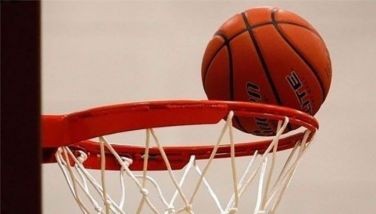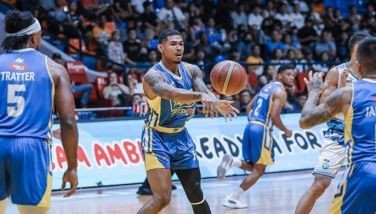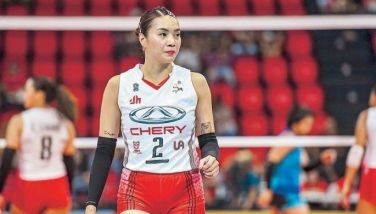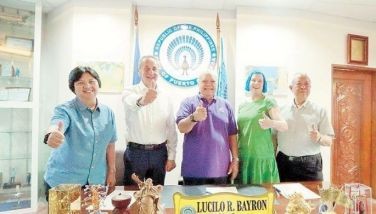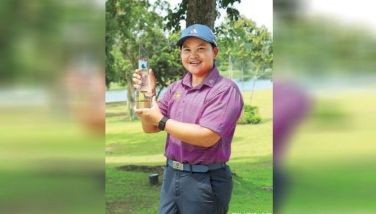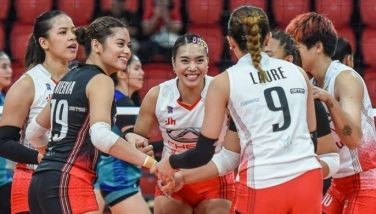STAR shines brightly
(Part 3)
This is the third and last instalment of our list of the 30 milestones in Philippine sports history over the last 30 years in celebration of The Philippine Star’s 30th anniversary.
• The torch of leadership is passed in Philippine athletics with former PSC chairman Philip Juico taking over from Go Teng Kok as PATAFA president. Since the 1996 Olympics, the Philippines has sent only two representatives in athletics. Roy Vence and Elma Muros were in Atlanta in 1996, Eduardo Buenvista and Lerma Balauitan in Sydney in 2000 and in Athens in 2004, Henry Dagmit and Marestella Torres in Beijing in 2008 and Rene Herrera and Torres in London in 2012. In Rio this year, athletics will be represented by Mary Joy Tabal in marathon, Torres in long jump and Eric Cray in the 400-meter hurdles. At the Southeast Asian (SEA) Games last year, the Philippines collected five gold medals from athletics with Cray winning two and Christopher Ulboc, Kayla Richardson and Caleb Stuart bagging one apiece. The last Philippine gold medal in the Asian Games from athletics came from Lydia De Vega in the 100-meter run in 1986 so that drought will be addressed in the next Asiad.
• The Philippines becomes the center of the Ironman 70.3 triathlon in Asia. Alaska CEO and fitness enthusiast Wilfred Uytengsu has been the prime mover of the campaign to make the country an Ironman hub in Asia and Pacific. Since 2009, Uytengsu’s Sunrise Events has staged the Ironman 70.3 here with an exponential rise in participation year after year. The popularity of the annual triathlon has spawned similar endurance competitions, not only providing a stage for the country to showcase its ability to host international events but also raising the level of consciousness in physical fitness across generations. This year will mark the first-ever Ironman 70.3 Asia Pacific triathlon in the country, a tribute to the tireless efforts of Uytengsu in bringing the sport in the country to a higher level.
• Filipino golfers make their mark globally. More and more Filipinos are excelling in international circuits. Miguel Tabuena, 21, will compete in Rio and two others were awarded tickets but Angelo Que and Dottie Ardina backed out. The fact that three parbusters from the Philippines could’ve played in Rio in golf’s comeback to the Olympics after a 112-year absence was a recognition of how the sport has progressed in the country. Frankie Miñoza, 56, remains a championship contender wherever he plays and the Asian Tour is packed with talent like Artemio Murakami, Tony Lascuña and Juvic Pagunsan. In the ladies circuit, Mia Piccio, Cyna Rodriguez and Jennifer Rosales are among the campaigners making waves overseas.
• The Philippines wins the Jones Cup in 1998 and 2012. Every year, Taiwan hosts the Jones Cup that gathers teams from all over the world with the Philippines always an attraction. Coach Ron Jacobs brought Northern Cement to the Jones Cup title in 1981 and San Miguel Corp. to the crown in 1985. Then, coach Tim Cone took the Centennial squad to the throne in 1998. Coach Chot Reyes became the first Filipino to win the championship with Gilas in 2012. This year, coach Bo Perasol is in line to join Reyes as the only Filipino mentors to capture the title with Mighty Sports on the way to the top.
• The Philippine Volcanoes bring rugby to the mainstream of national sports. With a platoon of Fil-foreigners leading the charge, the Volcanoes put the Philippines on the world rugby map. They topped the Asian 5 Nations Division III in 2009, Division II in 2010 and Division III in 2012. Now that rugby 7s is in the Olympic calendar, there is world-wide attention on the sport and a challenge for countries like the Philippines to step up efforts in raising their level of competitiveness. The Philippines entered the world rugby rankings at No. 71 in 2012 and has moved up to No. 62 and No. 55.
• Collegiate leagues flourish. While the UAAP and NCAA remain the country’s top varsity leagues, more and more collegiate circuits are prospering. Other leagues include NAASCU (National Athletic Association of Schools, Colleges and Universities), UCAA (Universities and Colleges Athletic Association), ISAA (Inter-Scholastic Athletic Association), ALCU (Association of Local Colleges and Universities), PRISAA (Private Schools Athletic Association), WNCAA, NCRAA (National Capital Region Athletic Association), SCUAA (State Colleges and Universities Athletic Association) and CESAFI (Cebu Schools Athletic Foundation, Inc.). The Philippine Collegiate Champions League (PCCL) was launched in 2002 and assembles over 250 titleholders in varsity leagues around the country in qualifiers enroute to the 16-team finals to cap each season.
• Laws are enacted to protect and provide welfare for athletes. Republic Act No. 10676 was passed in 2014 to guarantee high school graduates the freedom to choose their colleges without undergoing residency. Republic Act No. 10699 was made into law last year to standardize incentives and benefits for national athletes, including para-athletes, and coaches. Republic Act No. 10871 or the Samboy Lim Law was passed two weeks ago making it mandatory for basic education students to undergo age-appropriate life support training. The landmark law was Republic Act No. 6847 that created the PSC in 1990.
• Philippine swimming is in the crosswaves. Gone are the days of Filipino swimmers like Miguel Molina, Ryan Arabejo, Daniel Coakley, Eric Buhain and Akiko Thomson who all hit paydirt in the pool at the SEA Games. The Philippines failed to bag a gold in swimming in the last three SEA Games. In 2015, no Filipino claimed a gold out of 38 at stake in the SEA Games. In Rio, the Philippines is sending the same swimmers Jasmine Alkhaldi and Jessie Lacuna as in London four years ago. Swimming is wracked by dissension with the Philippine Swimming Inc. of Mark Joseph, the NSA recognized by the POC, in an irreconcilable tussle against the Philippine Swimming League of Nikki Coseteng and Susan Papa. Until the dispute is resolved, there may be no clear pathway to progress in Philippine swimming.
• The three annual nationwide sporting events are alive and running. The Philippine National Games began in 1994 and is an open competition which gathers elite athletes. The Batang Pinoy was started in 1999 and is a sports scout’s dream with amateur athletes 15-and-under congregating from different provinces. Palarong Pambansa, supervised by the Department of Education, traces its origins to 1948 and is participated in strictly by student-athletes from every region.
• PHILSPADA (Philippine Sports Association for the Differently Abled), established in 1997, evolves into the Philippine Paralympic Committee with Mike Barredo as its driving force. The Philippines has participated in the Paralympics since 1988. The country was represented by para-athletes in the last four Paralympics. Powerlifter Adeline Dumapong is the only Filipino to claim a medal with a bronze in 2000. At the ASEAN Para Games last year, the Philippine delegation was composed of 65 para-athletes who brought home 59 medals.
This completes our listing of the 30 milestones in the history of Philippine sports over the last 30 years.
- Latest
- Trending














